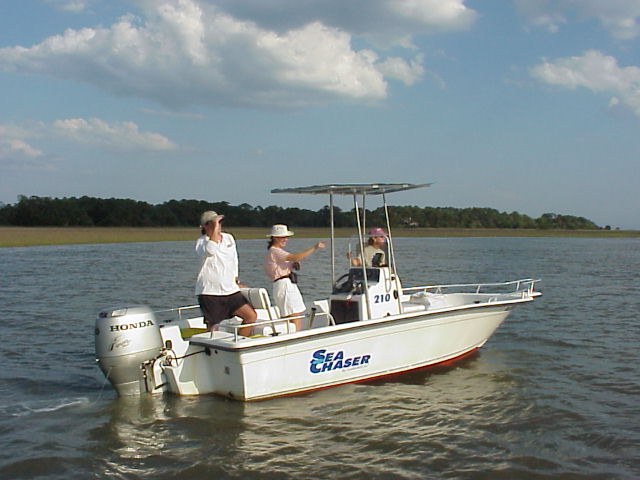

Come see the dolphins, bird life, alligators and more on our two hour guided nature tour of barrier island "Little Tybee" and the surrounding salt marshes.
"I've been coming down here for 35 years and this is the most enjoyable two hours I've spent!"
Michael Stanford
In the summertime when the shrimp boats are running the dolphin come out into the sounds and surround the shrimpers while they cull their catch at the end of the day.
Georgia's Coast is home to large numbers of Atlantic Bottle Nosed Dolphin in the wild. They work together to herd schools of small fish up the marsh creeks, then consuming them partially out of the water on the mud banks, an eating habit that is unique to the coastal low country.
Lexington,Tennessee

![]()
![]() Birding in the salt marsh is always rewarding with the year round appearance of Great Blue Herons, Great White Egrets, Snowy Egrets, Cormorants, Oystercatchers, Terns, Black Skimmers, Brown Pelicans and an assortment of plovers and sandpipers. At low tide we regularly see large groups of shore birds skittering about on the mudflats. American Oystercatchers are busily prying open their prey with long orange beaks shaped like oyster knives. The larger birds like Brown Pelicans, Cormorants, and Osprey come down from their perches to dive on fish. The Belted Kingfisher hovers poised in mid air waiting for the perfect moment to descend and scoop up a mullet. Brown Pelicans work in pairs diving alternately on schools of baitfish. The Black Skimmers glide along the surface catching fish with their large lower beak.
Birding in the salt marsh is always rewarding with the year round appearance of Great Blue Herons, Great White Egrets, Snowy Egrets, Cormorants, Oystercatchers, Terns, Black Skimmers, Brown Pelicans and an assortment of plovers and sandpipers. At low tide we regularly see large groups of shore birds skittering about on the mudflats. American Oystercatchers are busily prying open their prey with long orange beaks shaped like oyster knives. The larger birds like Brown Pelicans, Cormorants, and Osprey come down from their perches to dive on fish. The Belted Kingfisher hovers poised in mid air waiting for the perfect moment to descend and scoop up a mullet. Brown Pelicans work in pairs diving alternately on schools of baitfish. The Black Skimmers glide along the surface catching fish with their large lower beak.

![]() Little Tybee is an uninhabited barrier island that lies immediately south of Tybee Island. Being on the Atlantic flyway it is a resting area for many different species of birds on their migration north to summer breeding grounds and upon their return south in the fall. At high tide we can go by boat through the interior marshes of Little Tybee coming out sloughs into the ocean that are flanked on either side by stretches of pristine beach.
Combing the beach inevitably turns up a variety of different creatures and all the things they have left behind. The more adventurous groups enjoy seeing a mother alligator and her clutch of twenty-eight little ones. When they come out of hibernation in March you can often see them on the banks of the brackish pond where they live. We always maintain a healthy distance with the use of binoculars.
Little Tybee is an uninhabited barrier island that lies immediately south of Tybee Island. Being on the Atlantic flyway it is a resting area for many different species of birds on their migration north to summer breeding grounds and upon their return south in the fall. At high tide we can go by boat through the interior marshes of Little Tybee coming out sloughs into the ocean that are flanked on either side by stretches of pristine beach.
Combing the beach inevitably turns up a variety of different creatures and all the things they have left behind. The more adventurous groups enjoy seeing a mother alligator and her clutch of twenty-eight little ones. When they come out of hibernation in March you can often see them on the banks of the brackish pond where they live. We always maintain a healthy distance with the use of binoculars.
![]() Captain Rene Heidt
Captain Rene Heidt